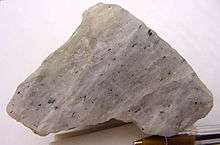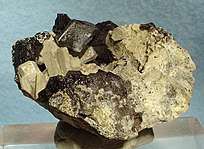Nepheline
Nepheline, also called nephelite (from Greek: νεφέλη, "cloud"), is a rock forming mineral in the feldspathoid group: a silica-undersaturated aluminosilicate, Na3KAl4Si4O16, that occurs in intrusive and volcanic rocks with low silica, and in their associated pegmatites.
| Nepheline | |
|---|---|
 | |
| General | |
| Category | Tectosilicate, feldspathoid |
| Formula (repeating unit) | (Na,K)AlSiO4 |
| Strunz classification | 9.FA.05 |
| Crystal system | Hexagonal |
| Crystal class | Pyramidal (6) H-M Symbol: (6) |
| Space group | P63 |
| Identification | |
| Formula mass | 146.08 g/mol |
| Color | White, Gray, Brown, Brownish gray, Reddish white |
| Crystal habit | Massive granular to prismatic |
| Twinning | On [1010], [3365], and [1122] |
| Cleavage | [1010] Poor |
| Fracture | Subconchoidal |
| Mohs scale hardness | 6 |
| Luster | Vitreous – greasy |
| Streak | White |
| Specific gravity | 2.55 – 2.65, average = 2.59 |
| Optical properties | Uniaxial (-) |
| Refractive index | nω = 1.529 – 1.546 nε = 1.526 – 1.542 |
| Birefringence | δ = 0.003 – 0.004 |
| Other characteristics | non-radioactive, non-magnetic, non-fluorescent |
| References | [1][2][3] |
Overview

Nepheline crystals are rare and belong to the hexagonal system, usually having the form of a short, six-sided prism terminated by the basal plane. The unsymmetrical etched figures produced artificially on the prism faces indicate, however, that the crystals are hemimorphic and tetartohedral, the only element of symmetry being a polar hexad axis. It is found in compact, granular aggregates, and can be white, yellow, gray, green, or even reddish (in the eleolite variety). The hardness is 5.5 – 6, and the specific gravity 2.56 – 2.66. It is often translucent with a greasy luster.
The low index of refraction and the feeble double refraction in nepheline are nearly the same as in quartz; but since in nepheline the sign of the double refraction is negative, while in quartz it is positive, the two minerals are readily distinguished under the microscope. An important determinative character of nepheline is the ease with which it is decomposed by hydrochloric acid, with separation of gelatinous silica (which may be readily stained by coloring matters) and cubes of salt. For this reason, a clear crystal of nepheline becomes cloudy when immersed in acid.
Although sodium and potassium are always present in naturally occurring nepheline in approximately the atomic ratio (3:1), artificially prepared crystals have the composition NaAlSiO4; the corresponding potassium compound, KAISiO4, which is the mineral kaliophilite, has also been prepared artificially. It has therefore been suggested that the orthosilicate formula, (Na,K)AlSiO4, represents the true composition of nepheline.
The mineral is one especially liable to alteration, and in the laboratory, various substitution products of nepheline have been prepared. In nature it is frequently altered to zeolites (especially natrolite), sodalite, kaolin, or compact muscovite. Gieseckite and liebenerite are pseudomorphs.
Two varieties of nepheline are distinguished, differing in their external appearance and in their mode of occurrence, being analogous in these respects to sanidine and common orthoclase respectively. Glassy nepheline has the form of small, colorless, transparent crystals and grains with a vitreous luster. It is characteristic of the later volcanic rocks rich in alkalis, such as phonolite, nepheline-basalt, leucite basalt, etc., and also of certain dike-rocks, such as tinguaite. The best crystals occur with mica, sanidine, garnet, etc., in the crystal-lined cavities of the ejected blocks of Monte Somma, Vesuvius. The other variety, known as elaeolite, occurs as large, rough crystals, or more often as irregular masses, which have a greasy luster and are opaque, or at most translucent, with a reddish, greenish, brownish or grey color. It forms an essential constituent of certain alkaline plutonic rocks of the nepheline syenite series, which are typically developed in southern Norway.
The color and greasy luster of elaeolite (a name given by M. H. Klaproth 1809, from Greek words for oil [ἔλαίον] and stone [λίθος]; German: Fettstein) are due to the presence of numerous microscopic enclosures of other minerals, possibly augite or hornblende. These enclosures sometimes give rise to a chatoyant effect like that of cats-eye and cymophane; and elaeolite when of a good green or red color and showing a distinct band of light is sometimes cut as a gem-stone with a convex surface.
References

External links
